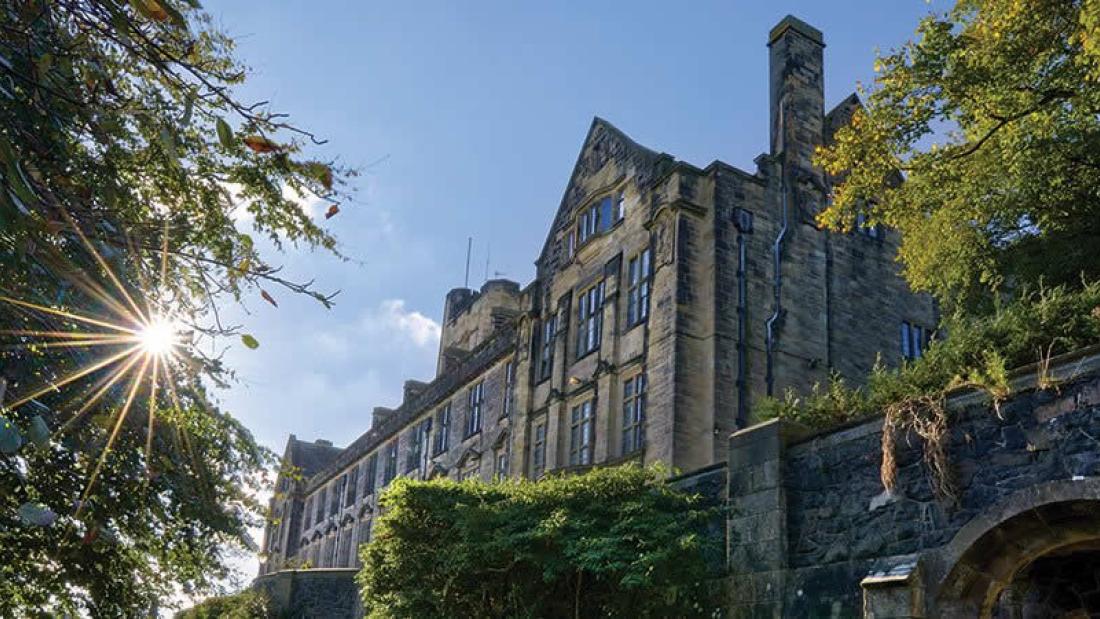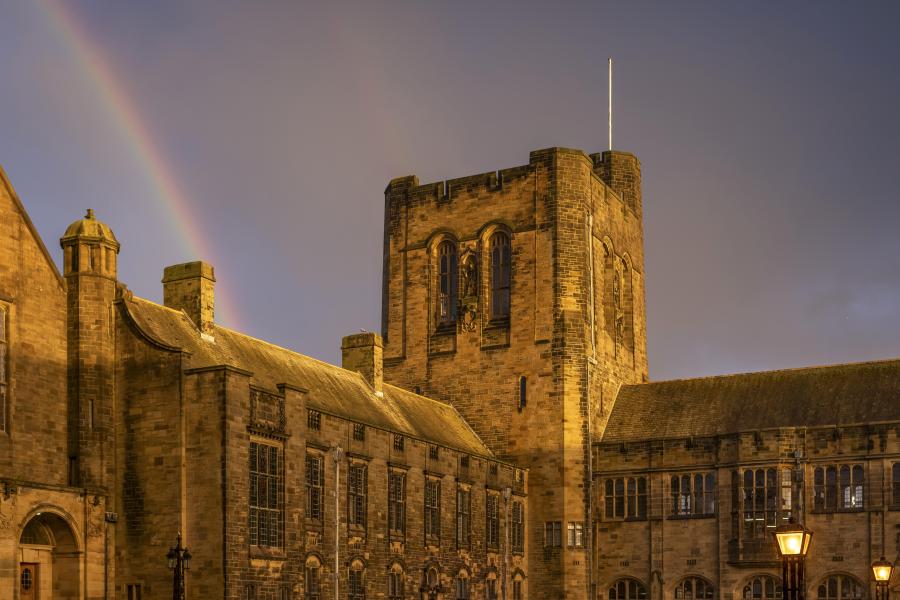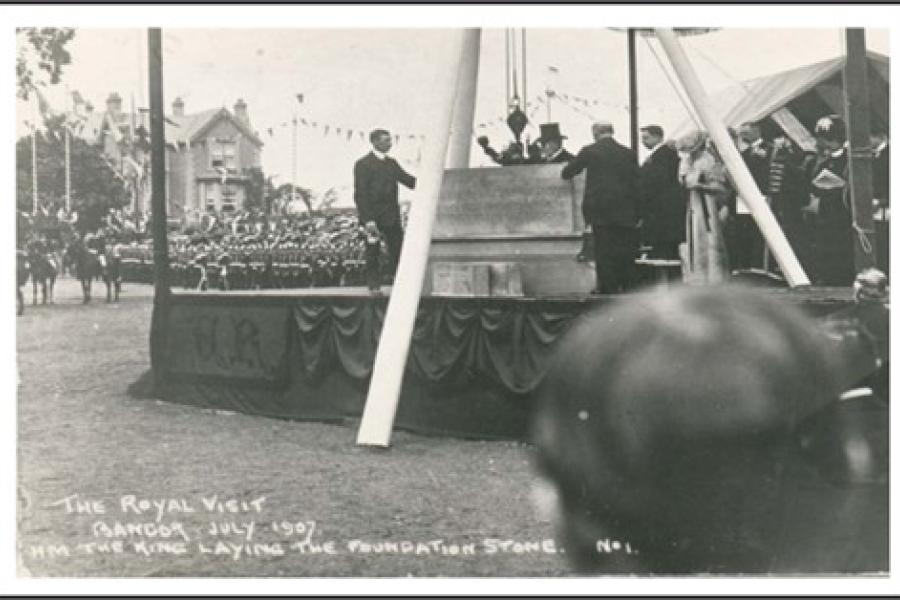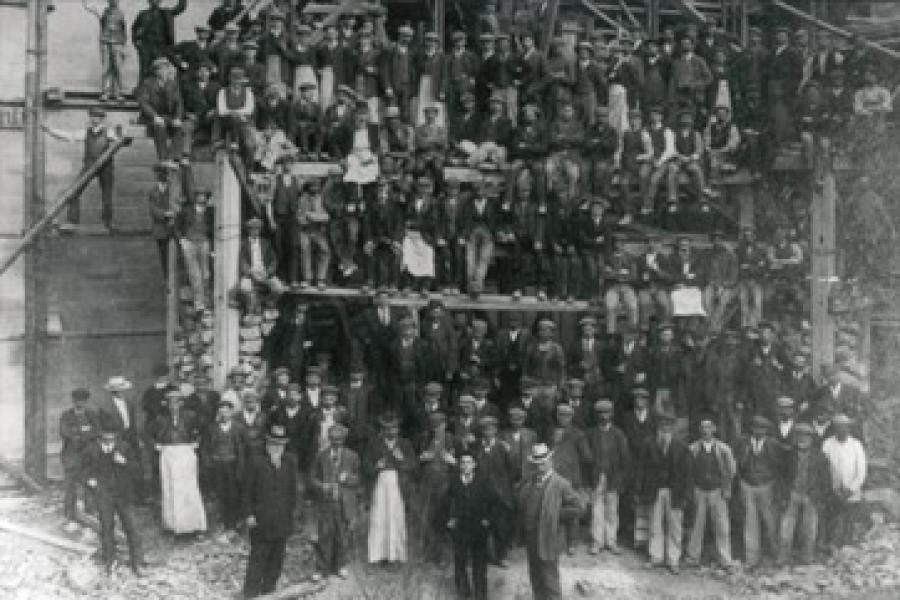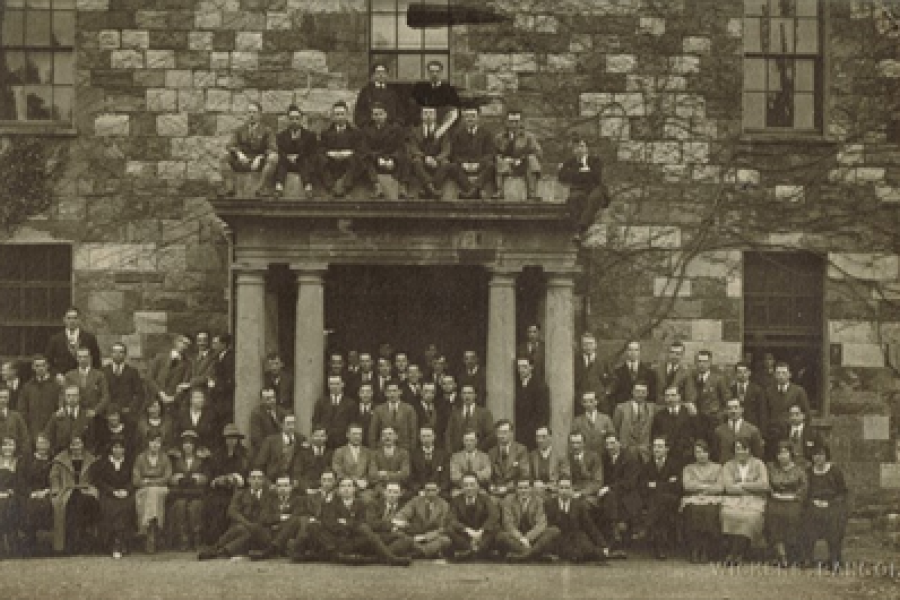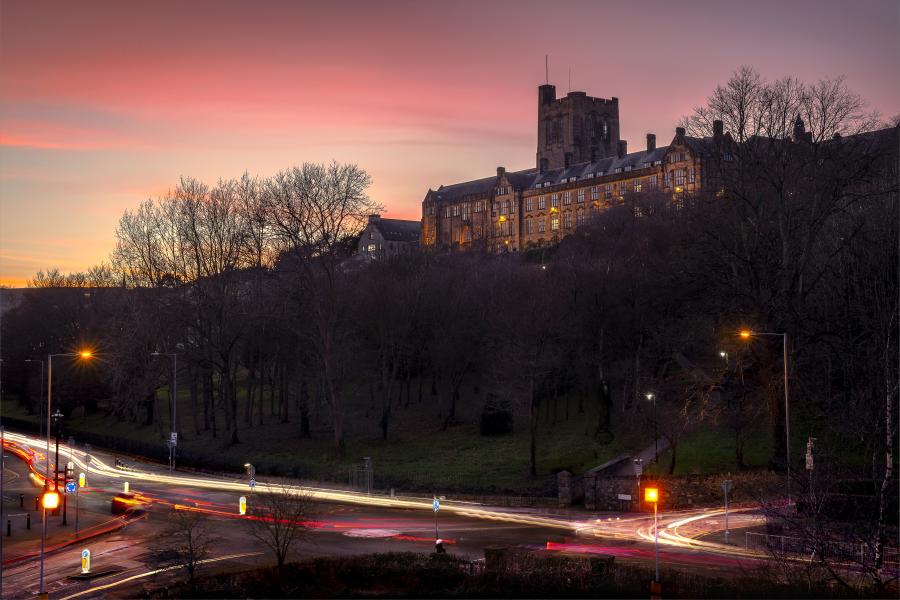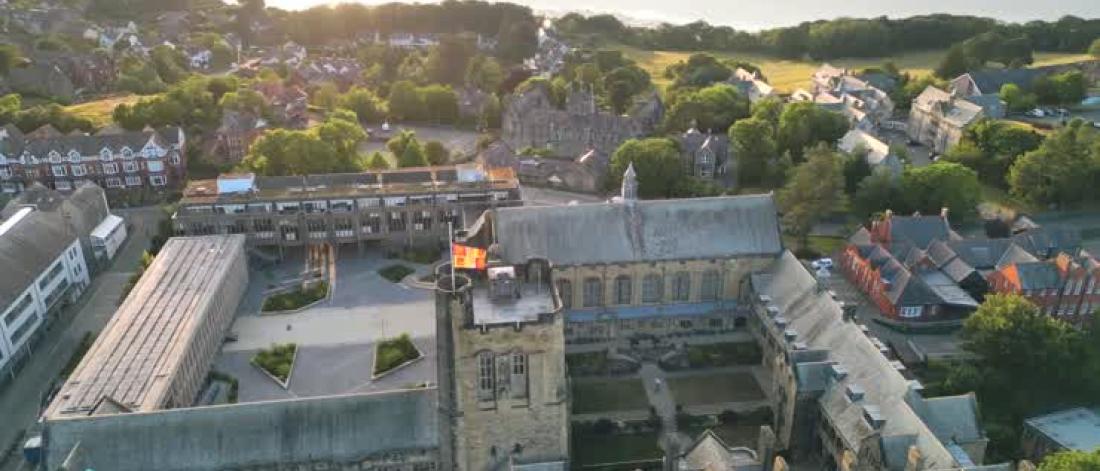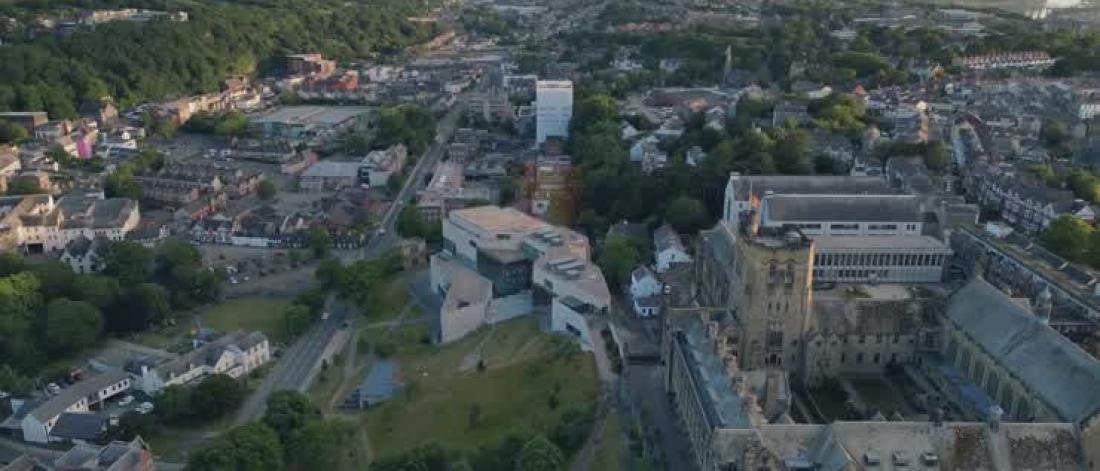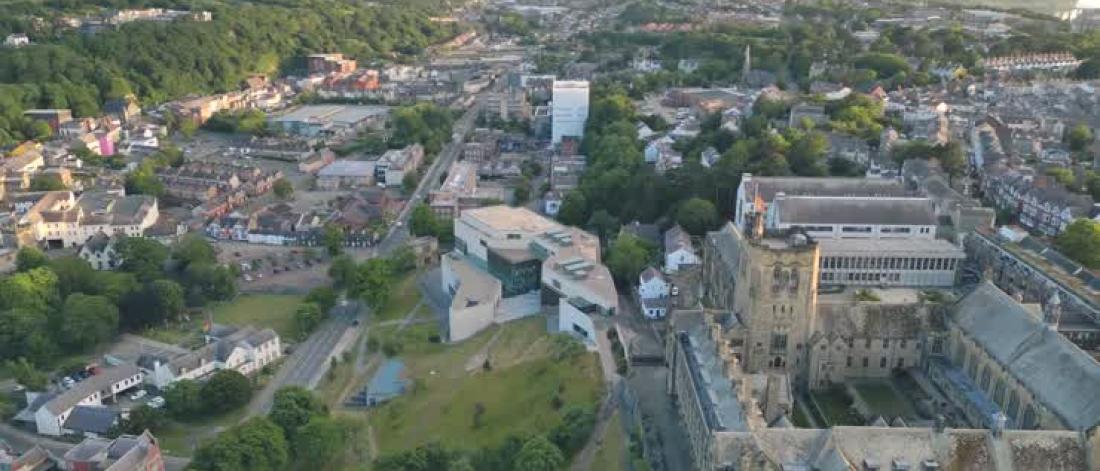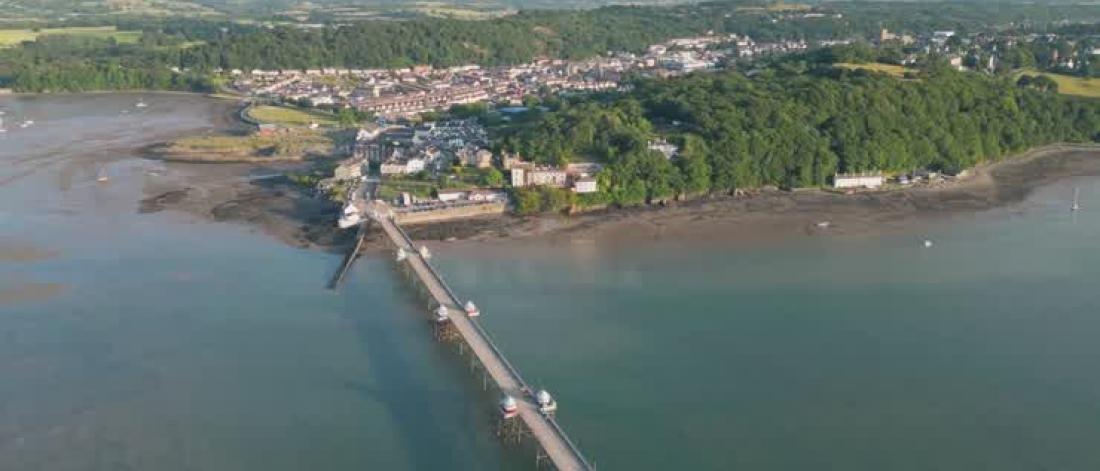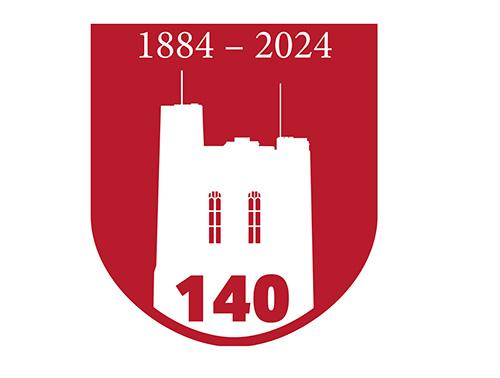
Celebrating 140 years of Bangor’s academic excellence and global impact.
2024 marks the 140th Anniversary of Bangor University, celebrating 140 years of academic excellence, world leading research, and transformative student experiences.
Join us as we revisit the legacy that began in 1884, and stay tuned as we share news on captivating events, and heart-warming stories to celebrate this big milestone.
The Beginnings
In the early 1880's a 3,000-strong procession of Gwynedd farmers, quarrymen and their families marched for education down Bangor High Street. They raised £1,200 to transform an old coaching inn, Penrhyn Arms into what was then known as University College of North Wales.
The University opened its doors on the 18th October 1884 to 58 students and had ten members of staff. Students were initially conferred degrees by the University of London, until 1893 when Bangor became one of the three original constituent colleges of the University of Wales.
The very first student to enrol at Bangor University was female. Mary Ellen Williams was a lady of ordinary background, not one of wealth and stature as you might expect. She was a local girl, the daughter of a grocer. Female students actually made up a third of the student population in those formative years – which was unusual for its time.
One of the first females to graduate from the University was Margaret Verney from Plas Rhianfa on Anglesey.
Women were to contribute greatly to the growth of university education in Wales.
In 1903, Bangor's city council donated a 10-acre plot of land overlooking the city for construction of a new, bigger university building. Lewis D Jones (Llew Tegid), a local headteacher, led fundraising efforts across Gwynedd and Anglesey to help fund the new building. Thousands of farmers, quarrymen, local people contributed towards the goal of raising a huge £120,000.
The foundation stone was laid in 1907, and four years later in 1911 the main building was opened by Royal visit.
History of Bangor University in Film
Throughout this Anniversary year, the University is launching a series of six films telling the captivating story of the history of Bangor. Join local historian and businessman, Gari Wyn as he takes us on a journey through campus and the city of Bangor, with some special collections also showcased by Bangor University’s Archives Department.
00:01
Join us as we explore the captivating story of how Bangor University came to be.
00:10
The story of how Bangor University started is a captivating one.
00:15
I'm Mari, studying Childhood and Youth studies here at Bangor University and this is the first in a series of six films where we
00:26
explore the history of Bangor University and how the small University on the Hill became the global influence that is today.
00:33
Here to take us on this fascinating journey is Gari Wyn, local historian, businessman, and graduate from Bangor University School of History.
00:41
So what can you tell us about how this story began? {Gari} Well, it all started in in the 1880s, and the first college was opened in 1884.
00:50
But we're standing here now in the new college, which was opened in 1911.
00:59
And right above us, we have the central tower of the college, which has four statues on it.
01:04
The ones we see from here are David, the patron Saint of Wales.
01:09
Next door to him is Llywellyn Ap Griffith. On the other side, we have Owen Gwynedd, who's buried in Bangor Cathedral down the road here,
01:13
down at the bottom of the hill, and also Owain Glyndwr
01:21
And the important person amongst those four is Owain Glyndwr because he had the vision in 1404 to have an independent Parliament
01:24
for Wales and an independent church for Wales and possibly more significance for us here,
01:33
an independent self autonomous university for Wales.
01:38
And how long did that take? {Gari} Well, when you work it out, it's 480 years isn't.
01:43
And with the drive and the vision of the people of Gwynedd and Anglesey, we finally had what Owain Glyndwr hoped he would have in 1404.
01:48
It's all started with the local people getting behind the local business leaders,
01:58
securing this building called the Penrhyn Arms and adapting it to be the university.
02:03
The doors opened and the processions came from all over for the opening ceremony.
02:09
I suppose you could say it was one of the earliest records of crowdfunding.
02:18
That's a good way of putting it. The whole community came together.
02:22
A non-conformist, traditional, old fashioned Welsh community farmers, poor farmers,
02:25
wealthy farmers, prominent businesspeople and especially the Quarrymen.
02:30
The Quarrymen actually gathered together 1200 pounds of their own money to start off the
02:34
conversion of the Penrhyn Arms Hotel to turn it into some kind of modern university.
02:40
And this was a massive challenge at the time.
02:46
The next step, obviously, was to gather the rest of them, and actually came to 35,000 to add that to the building.
02:48
Then we had a great procession to open the building in front of the Penrhyn Port here and down at the sea,
02:55
and opened the building in October 1884. That actually was a fantastic day in the history of Bangor.
03:02
We had a great procession and we should remember that Bangor High Street is the longest high street in Wales.
03:08
So the culmination of the day was 3000 people, a cross-section of all people in the local society, and we were on the way.
03:15
This obviously is the foundation of the education that you are receiving here today.
03:25
And how many students were registered here back then?
03:30
Well, there were 58 in the first year. But the staggering statistic is that there were 19 women out of those 58.
03:34
And that was totally unheard of throughout education in the whole of the UK at the time.
03:42
And for this to happen, the little city of Bangor shows that we've always been on the forefront of education,
03:48
always thinking of new ideas and developing and evolving as we go along.
03:54
Do we know anything about those first female students?
03:59
We have a lot of information about them. Probably the most prominent one was Margaret Verney, a member of the Plas Rhianfa family on Anglesey.
04:02
She became the first woman graduate. But more important is that she gave 30 years of her life towards promoting women's education.
04:11
And she became a member of the university council, which she remains for for the next 30 years.
04:21
And she contributed greatly to the history of the University of Wales and to women's Eduication in the UK generally.
04:28
Hello, Sian. What can you tell us about the first principal and professors here? Who were the first to teach?
04:36
Well, how did a Hill, an Irishman of German descent.
04:43
Was the first principle here. And he played an important role in establishing the university for nearly 50 years.
04:46
He learned Welsh fluently. He had the vision for the for the college, and he established and bought new people around him.
04:55
And how did the university establish itself and develop financially?
05:02
Again, by making connections. We had people like William Rathbone, the Liverpool MP who became an MP for Caernarfonshire also.
05:07
But later on, as Lloyd George became more prominent and liberalism,
05:15
he pulled in very wealthy business people from Merseyside and also from all parts of North Wales and everybody contributed.
05:20
He started new subjects, a forestry, for example.
05:27
Also the classics came to Bangor with possibly more pioneering than anything was his contribution to agriculture,
05:31
because agriculture was obviously a prominent part of the life of everybody here in Gwynedd and Anglesey.
05:38
What a great way to end this, first in a series of films.
05:44
Thanks. Follow the next part of this fascinating story by joining us in part two.
05:48
The vision of 1884, the growth of the university and its buildings.
Part Two - The Vision of 1884
1
00:00:02,960 --> 00:00:09,950
This is Bangor University, one of the first universities built in Wales and now within the top five in the UK.
2
00:00:11,670 --> 00:00:16,080
I'm Mari studying childhood and youth studies here at Bangor University.
3
00:00:16,470 --> 00:00:25,380
And this is our second in our series of six films where we explore the history of Bangor University and how the vision of 1884 evolved.
4
00:00:26,190 --> 00:00:35,160
Here to take us on this fascinating journey is Gari Wyn a local historian, businessman and graduate from the Bangor University School of History.
5
00:00:35,520 --> 00:00:38,850
So what can you tell us about how this part of the story starts?
6
00:00:38,970 --> 00:00:49,710
Well, from 1884 onwards, the college gradually expanded from its base down there by the port in the old Penrhyn Hotel.
7
00:00:49,860 --> 00:01:00,870
We needed a bigger university going gradually from an University of 60 students gradually by about 1890 to about 600 students.
8
00:01:01,650 --> 00:01:05,670
All of a sudden, the rural communities called for a new college.
9
00:01:06,180 --> 00:01:17,040
Between 1884 and 1893, the college evolved and more prominent local people, local businesspeople,
10
00:01:17,040 --> 00:01:28,680
local farmers and the coming of Lloyd George as an MP in 1890 made it inevitable that before long a new grand university would have to be developed.
11
00:01:29,130 --> 00:01:35,910
We're now obviously standing beneath the climax of the progress which was going to be built by 1911.
12
00:01:36,210 --> 00:01:46,330
So we needed money. The college and the MP's, such as William Rathbone and Asquith in London, also was behind this a prime Minister to be before long.
13
00:01:46,350 --> 00:01:51,030
Was there large amounts of crowd funding?
14
00:01:51,180 --> 00:01:53,639
This all started with a man called Llew Tegid
15
00:01:53,640 --> 00:02:01,200
who was appointed as the chief fundraiser towards the building of the new college, and that started in about 1905.
16
00:02:01,380 --> 00:02:09,180
This culminated in 1907 with the actual unveiling of this stone by Edward VII, as you see, in July 1907.
17
00:02:09,330 --> 00:02:19,560
Underneath the stone as a matter of interest are the publications in the local press at the time celebrating the actual event underneath the stone.
18
00:02:19,740 --> 00:02:26,100
Further down here is the name of Henry Hare, the architect who was responsible for this magnificent piece of architecture,
19
00:02:26,400 --> 00:02:30,120
which can't really be compared to anything in the whole of the UK.
20
00:02:30,320 --> 00:02:36,300
Yes. Gosh, that's incredible. And here we are in the stunning Shankland Library.
21
00:02:36,600 --> 00:02:44,000
What can you tell us about this building Gari? Well, the structure of the building was paid for by the Royal Drapers' Society.
22
00:02:44,010 --> 00:02:48,690
Very apt considering that the woollen industry was so important for the people of this area.
23
00:02:49,020 --> 00:02:58,740
So they paid for the structure. A man called Owen Owens, who was a foremost department store business man from Liverpool and London.
24
00:02:58,980 --> 00:03:03,720
He paid for all the wood work which is made by with Austrian Oak.
25
00:03:04,230 --> 00:03:14,430
We also have a unique feature in the roof of all the coats of arms for the different counties and purchases of Wales between 1907 and 1911
26
00:03:14,430 --> 00:03:23,400
Thomas Shankland was given the task of creating a massive collection of the most valuable books and rarest books in the history of Wales.
27
00:03:23,700 --> 00:03:28,559
So we have just one totally unique, unbelievable building,
28
00:03:28,560 --> 00:03:37,470
which I don't think can be matched by any university anywhere across the world.
29
00:03:37,530 --> 00:03:44,160
So here we are inside the building. What exactly can you tell us about the history of this hall?
30
00:03:44,190 --> 00:03:49,320
Well, we need an hour to do it all Mari but as you can see, it's a really majestic building.
31
00:03:50,460 --> 00:04:00,390
Sir John Pritchard Jones who was given the Baronetcy award for his contribution financially of £15,000 to build this magnificent hall.
32
00:04:00,600 --> 00:04:06,509
And it was based really on an idea that it would then include a great hall
33
00:04:06,510 --> 00:04:12,649
and this was basically the Lloyd George's idea, because he did feel that if we were going to have such a fantastic building in Bangor
34
00:04:12,650 --> 00:04:16,480
as a new university that we would also need a great hall like they did
35
00:04:16,530 --> 00:04:23,960
in Balliol and Jesus College in Cambridge and as you can see, the building itself held 1500 people.
36
00:04:24,360 --> 00:04:34,679
We're standing on the balcony now around us, these oak panels from Austria, these great windows, the cultural arms of all of the countries of Wales,
37
00:04:34,680 --> 00:04:43,470
and possibly more interesting than anything, the first Great Hall in any university in the UK to have what they called electroliers.
38
00:04:44,550 --> 00:04:53,040
These lights were actually chandeliers infused with electricity and that is a really,
39
00:04:53,040 --> 00:04:59,160
really pioneering thing for any hall to have in Britain in in the 1911 period.
40
00:04:59,970 --> 00:05:06,900
Thanks again, Gari. It really does put a different perspective on these corridors that our students walk through daily.
41
00:05:08,010 --> 00:05:12,180
Join us next time when we discover more about this amazing university.
Part Three - The Key Players
00:00:02,380 --> 00:00:08,170
Join me, Mari, as we explore the history of Bangor University and the key people involved.
00:00:08,870 --> 00:00:12,370
Hi Gari. Why are we here in Glanadda Cemetery?
00:00:12,530 --> 00:00:17,889
Well, we are right at the centre of the cemetery here, where a number of prominent people
00:00:17,890 --> 00:00:22,180
who played such an important part in the establishing of the early years of the university
00:00:22,420 --> 00:00:31,270
as we come down to the corner here, we come to William Cadwaladr Davies, the first secretary, the first registrar of the college, a Bangor boy from Hirael district
00:00:31,270 --> 00:00:33,710
at the bottom here who played
00:00:34,030 --> 00:00:42,070
a very prominent part in the establishment of the body of the University of Wales ten years after the university was sold.
00:00:42,160 --> 00:00:45,490
We have a number of other people here around as well, Llew Tegid
00:00:45,760 --> 00:00:51,280
the man who was responsible for collecting all the money. And on the other side, the mayor of Bangor, Sir Henry Lewis.
00:00:51,300 --> 00:00:57,550
But just nearby, we have another very, very important player in the in the whole story.
00:00:57,790 --> 00:01:01,310
So here we are at the grave of Sir Isambard Owen, why are we here?
00:01:01,320 --> 00:01:07,600
Isambard Owen was very influential in all aspects of development of the college.
00:01:07,840 --> 00:01:14,799
He also played an important part in the development of universities in London, in Paris and in Durham.
00:01:14,800 --> 00:01:23,170
So he's one of the possibly one of the the most important people in the history of university education in the whole of the United Kingdom.
00:01:25,060 --> 00:01:34,770
Right. So we're here in Neuadd Reichel and was this building named after Harry Reichel who was the first principal of the university
00:01:34,950 --> 00:01:38,819
Harry Reichel, from his Irish and German descent,
00:01:38,820 --> 00:01:44,430
was the first headmaster or first principal of the college from 1884 till 1927.
00:01:44,730 --> 00:01:48,720
And yes, this building which is a hall of residence was built in his memory.
00:01:49,050 --> 00:01:54,090
He's a very, very important part of the development of not only the University of Bangor,
00:01:54,090 --> 00:02:03,989
but of education in Wales and also in parts of the UK as well, because he was a pioneer in developing new departments.
00:02:03,990 --> 00:02:10,680
For example, in Bangor he united all the religious denominations to create one theology departments.
00:02:10,900 --> 00:02:19,440
He created the classics departments. He created the forestry departments under very important and significant agricultural departments.
00:02:19,680 --> 00:02:31,260
So the realms of the influence he has had on education in, within the University of Wales is just unbelievable.
00:02:31,770 --> 00:02:36,240
From this same period, Sir J. E. Lloyd became registrar of the College.
00:02:36,510 --> 00:02:41,430
He published research and the volumes of notes on the history of Wales to this day,
00:02:41,430 --> 00:02:49,380
his work on the history of the Middle Ages and Owain Glyndŵr remain the main source of the history of Wales in that period.
00:02:49,590 --> 00:02:53,460
A prominent woman also in the history of the College was Mary Rathbone,
00:02:53,910 --> 00:03:00,510
a member of the famous Rathbone family from Liverpool, who had grown up in Llandegfan, Anglesey.
00:03:00,510 --> 00:03:05,729
Was she related to William Rathbone, who helped set up the university?
00:03:05,730 --> 00:03:11,280
Didn't we speak about him in our previous film? Yes, they were a very influential family.
00:03:11,280 --> 00:03:14,730
During that time, Mary became a member of the University Council,
00:03:14,910 --> 00:03:21,090
and she was also a generous patron of the cause of women's education throughout the United Kingdom.
00:03:21,330 --> 00:03:29,880
She was also a member of the board, which was responsible for the great fight for the rights of women to have independent halls of residence.
00:03:30,390 --> 00:03:33,450
So there was a female only halls of residence then?
00:03:33,450 --> 00:03:40,890
The first official one was probably the one that was opened in 1893, which was the University Hall.
00:03:41,310 --> 00:03:46,530
The first girls in the college would range in age between 16 and 26 years of age.
00:03:46,890 --> 00:03:57,750
and finally in 1893, Reichel made sure that they had the money and they built the new University Hall, which is presently Rathbone Hall.
00:03:58,020 --> 00:04:04,530
And that was the start of a totally independent way of life for the young women within education in Wales.
00:04:04,710 --> 00:04:11,610
And that was at the time, something really pioneering that hadn't happened in most universities throughout the United Kingdom.
00:04:11,790 --> 00:04:15,450
I think everyone would agree we've come such a long way since then.
00:04:16,650 --> 00:04:22,950
Join us next time as we move to more recent history to find out how the university embraced bilingualism.
Part Four - The 1970's at Bangor
0:01
This is Bangor University, a global university powered by a common spirit. Its pride in its Welsh history and heritage, and a deep commitment to being part of and building communities.
0:15
Hello again Gari. So we're now moving into more recent history aren't we? In this episode, we will be discussing how students' voices make big changes.
0:26
I suppose then we have to start in about 1958 with the coming of Sir Charles Evans, a famous mountaineer, a member of the 1953 Everest team who started here as principal in 1960. That was a beginning of a really age of conflict in the history of the university, because all of a sudden, all universities in Britain, because of the Robbins report, were under pressure to expand.
0:55
And obviously, as time went by, it meant that Bangor had new University Halls, such as Plas Gwyn and Emrys Evans, which we have around us here. And the after effect of that is that there were many people from the Welsh contingency of the college were very worried about the effect this would have on the Welsh culture and the Welsh language as a teaching medium within the college.
1:25
And here we are now in Pontio with our current president of UMCB, Celt John. And Gari, can you tell us a bit about how UMCB came to be? Well, before the Welsh speaking Students' Union started, there was a society called the Cymric. And during the beginning of the 70s it gradually changed from being an organisation which organised social events and literary events and debating events to be more political in its outlook towards the college and that was basically because of the simple fact that the college was expanding following the Robbins Report and
2:05
Sir Charles Evans, the famous mountaineer who was so keen to expand the whole college. And and those days were days of tumultuous changes. The next part of the story is organising rallies and the students taking over and occupying many of the buildings. The New Arts buildings for example. And the after effect of that was to organise a great rally with Dafydd Iwan, the famous international singer, by now addressing a crowd of 3000 people. And it went from one step to another. Protest in 1974 led to four of the leaders of the new Cymric society being banned from the college.
2:50
And another four years after we established the UMCB, the the Welsh speaking union, the protests became much more severe, and that led in 1978 to four leaders having to leave the college for two years. In 1976, the UMCB became the official body on behalf of the Welsh students and the body which you are the president of today Celt.
3:23
Yes. What became of that unrest then, afterwards? I suppose what you would say is that for a time nothing happened. But the college itself realised that they had to do something. They appointed two prominent professorship, Gwyn Thomas and Alwyn Roberts to take charge of promoting courses and new syllabuses through the medium of Welsh and gradually the respect shown towards the Welsh language and that was due in the end to this body which we refer to today as UMCB.
4:02
Yes and just to add on to that, I can say as the current president that, you know, the fruits of your labour has definitely paid off. We are the leading university in Wales regarding the provisions of Welsh language and the amount of courses that one can study through the medium of Welsh.
4:23
And just to add on to that, I can say as well that the student voice is more important nowadays than it ever has been. Inclusivity is very, very important to our values here at Bangor University. Thank you once again, Gari and Celt. The 70s and 80s were a really fascinating time in the university's history, marked by big transformations and led by both students and staff.
4:52
It seems Bangor University's always valued its vision, bravery and pioneering spirit. Join us next time for the penultimate film in our series.
Final Part - Women at Bangor University
00:00:01
This is Bangor University, an institution that for over 135 years has made incredible contributions to a global society. Join us as we continue our journey through the corridors of educational history. I'm Mari and this is the last in a series of six films. We end this series by celebrating some of the huge successes from those early female graduates.
00:00:26
Here to tell us all is Sian Robinson from the Bangor University's Archives Department. Hello, Sian. I'm looking forward to hearing about how those female graduates were treated in those early days. We've already heard in some of our previous films that the female students made up a third of the population in those formative years. Now, that was unusual for its time, wasn't it Sian? Well, yes, it really was.
00:00:54
The founders of Bangor University wanted to set up a university that wasn't political, that wasn't based on wealth and was liberal. Women were actually welcome to UCNW right from the beginning. In universities like Oxford, women were not allowed to graduate until the 1920s, and in Cambridge not until 1948, so much later.
00:01:22
Here at Bangor, women were welcomed right from the start, and they graduated right from the start. Am I right in saying that the first students to enrol in the university in 1884 was actually female? Yes. And she came from a very ordinary background. Her name was Mary Ellen Williams and she lived in Upper Bangor. She was the daughter of a grocer. In fact, she only completed three terms here at Bangor and we don't know the reasons why, but that was actually quite the thing at the time for women.
00:02:00
They would come to Bangor, but they wouldn't always graduate. We're so lucky in that we have the first registration book for these early students at the Bangor Archive. And the first name on that register is a woman's name - Mary Ellen. Fascinating. And we've already discussed Mary Sutherland, who is the first female forestry graduate.
00:02:27
Who else made an impact on the world? Well, what about Rosa Mabel Lee? Now we have a photograph of Rosa taken about 1903 with her co students. Rosa was a girl from Conwy. Her father was a civil servant and Rosa studied mathematics here at Bangor and got a B.A. She was actually our first woman student to graduate in mathematics here at Bangor
00:02:57
and she went on to become a statistician and had an incredible career, which led her to to be the first woman who worked for the Marine Biological Association. So why are we stood in front of this mural. Well, I want to introduce you to Kate Roberts. Kate was a quarryman's daughter from Eryri, Snowdonia and she graduated from Bangor in 1913.
00:03:28
Now, Kate went on to run a major printing press and publish the main Welsh national newspaper. She helped found Plaid Cymru, the Welsh nationalist Party and she campaigned tirelessly for the Welsh language. Kate also challenged gender stereotypes in traditional patriarchal Wales. And she produced a body of literary work in the Welsh language, which ranks her as one of the greatest Welsh writers of the 20th century.
00:03:56
She is known as the Queen of Welsh literature. Wow that's amazing. And what about scientists? Were there any female scientists? Well, what about Phyllis Violet McKie? She was a chemistry graduate in 1917. Her father was a clerk at the Penrhyn Quarry offices in Bangor.
Phyllis, among other chemistry graduates, took a very important role during the First World War.
00:04:26
But Phyllis was the main woman. She went on to devise explosives for the War Ministry. Thank you, Sian. This has been truly inspirational. So as we end our journey through the history of Bangor University, we are reminded that Bangor has always been at the forefront for innovation and progress. Throughout this series, we have explored the stories of the pioneering individuals who have shaped the university's history, from the first Welsh Students' Union, to the trailblazing female graduates who challenged gender norms and helped pave the way for future generations.
00:05:07
We hope that this series has given you a greater appreciation for the remarkable legacy of Bangor University and inspired you to learn more about what the University offers the world today. Thanks for joining us on this journey and we look forward to the many more chapters yet to come.

